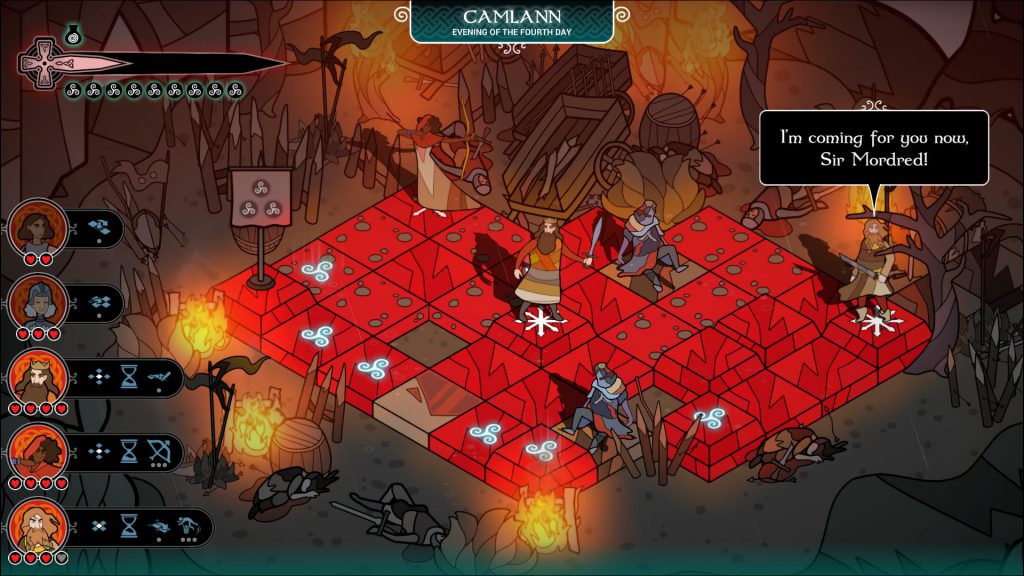Pendragon — Bleak Hope
Inkle are masters at creating stories. Using their scripting/storytelling language Ink they have created the wildly popular 80 Days, and one of my favourite games of last year, Heaven’s Vault. But now Inkle decided to swerve in a completely different direction with the use of Ink by creating Pendragon — a tactics turn-based strategy.
Classic Father-Son debacle
Pendragon is a turn-based tactics game based in the Arthurian times. The Camelot has fallen, and now Mordred, Arthur’s son, is starting an invasion, trying to usurp the throne and become the King of England. The player, taking the role of one of the well-known characters from the legends, must go through the country, and meet up with Arthur to try and stop Mordred’s assault.

On the way the characters can meet and recruit people to their cause which results in additional party members during the fights. But the food is scarce, enemies are everywhere, and morale needs to be kept up, otherwise the story might end sooner than wanted.
Standing in a church
Inkle creates beautiful games, and Pendragon delivers as well. The artstyle is very reminiscent of medieval illustrations, but modernized to fit contemporary times. The characters have bold outlines, and are composed out of blocks of flat colors, making them look almost like they’re made out of stained glass.
The rest of the game also fit this aesthetic — the maps and environments are composed to fit the style, and the general sadness and somberness of the game. Oftentimes, even though colorful, the world feels bleak and hopeless. The places the characters move through feel abandoned and decrepit, even if they’re lived in.

The audio enhances the mood of the world as well. Most of the time the only thing that can be heard is the whistling of the wind and the environment. But if the music does play, it’s subdued but full of hope, and during battles it is inspiring, full of drums. The sound effects also feel in-character to the rest of the audio, with characters making sounds that make sense for the occasion.
Swords and stories
Pendragon has two main mechanics, one of which spins the genre’s aspects, and the other which makes it take a completely different path than the rest of the games in that genre. The former is the battle system, and the latter the conversations and story of the playthroughs.
Battles take place on an isometric grid, with sides taking turns taking a single action with one of the characters. However, instead of a simple move range and attack range, fighters have two stances they can switch between as an action — combat, and scouting. In scouting stance knights can only move diagonally, and will claim adjacent squares, but cannot attack.

And claiming squares is what makes the combat stance interesting. Normally, the units can only attack enemies on adjacent (non-diagonal) squares, but can also charge through claimed squares in a single move when moving forward. This, combined with the fact that only one action can be taken per turn makes the game feel more like Chess than Fire Emblem.
Additionally, the player only starts a fight with only one character present, but can summon more — for a price. Resolve can be gained by entering certain spaces, oftentimes it being a high ground which allows for movement in all directions. Each side has a starting point — if the player can access the enemy’s point before the end of the fight they can bypass it, but if an enemy combatant ends up on player’s point then they might kill one of the unsummoned fighters.
The fighters can be important parts of the story. And the story is what differentiates Pendragon from other tactics games — Inkle are masterful storytellers, and known for creating systems that make the characters and places seem even more lifelike. This time each of the characters have unique goals (named core story) that can change over time thanks to actions taken in-game. The goals also have in-game consequences, as they change the knight’s special ability that can be used in-fight.
The story can, and will take place anywhere — protagonists will discuss things during travel, tell each other stories during rest, and will talk with both friends and enemies during encounters. Some of them can even be bypassed or changed by the way the player’s knight will answer or ask questions.

And this is where Pendragon thrives. The story of one knight trying to survive can suddenly become a story of a group of different characters rushing to get to King Arthur as soon as possible to try this bleak world from becoming even bleaker. And even if you fail, if Mordred kills Arthur, you can always start again, maybe with a different knight that you recruited on the way. There’s always hope. Bleak hope.
Conclusions
I originally didn’t expect much from Pendragon. I knew Inkle made great games, but couldn’t see how their wonderful storytelling could be injected into a game of this genre. But I’m glad I gave it a try, and realized how much can be changed and improved in one of my favourite genres.
Pendragon is available on Steam, GOG.com and the Mac app store.
Comments are closed.